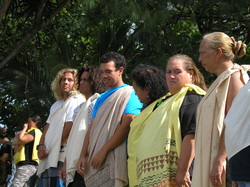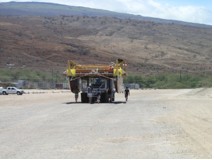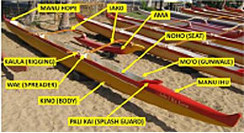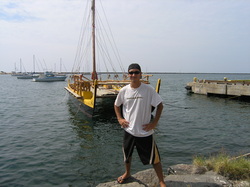
 Kaimana Bacarse
Kaimana Bacarse The crew was a special blend of original and first time voyagers, creating a flow of knowledge and experience and a sense of unbroken continuity. “We did what Maui did. We connected a lei of islands. We strung together a lei of islands from French Polynesia to the Cook Islands to Samoa. For these are the highways of our ancestors and what's connecting our generations. The beauty of this voyage for many was that transference of knowledge. That transference of mana (spirit), that sharing of aloha between generations,” Bacarse said.
 Cesi Hao
Cesi Hao Voyaging connects the navigator and crew with the natural world in both tangible and intangible ways. To navigate and survive the navigator has to read the physical signs of the oceanic world, but there are times when it is the intangible spiritual connections that bring the canoe into port. Cesi Hao, apprentice navigator was fortunate to experience this. “Earlier in the morning at the end of our trip, I saw Manu'a, our target island. I could see it looked like a grey cloud but I could tell it wasn't because it had a sharp cut off. It looked like a cone. So I looked over at Tua [Pittman] and he said, 'Keep it in your mind because as soon as the sun gets higher, you're going to lose it.' So I held on to it but as I was trying to capture where it was, this huge squall comes from behind, takes out the sun. By the time we were going to arrive it was complete cloud cover, pouring rain and I looked at Tua and I said, 'I 'm lost. I don't know where I am.’ And he said, 'Now's the time to throw everything you know out. Whatever you know, what you see throw it out. You feel your way home.' We don't just go off of the physical things around our environment. You rely upon akua and you rely upon your ancestors to guide you. Because in that moment when you have nothing else left they're what's going to pull you through.” Hikianalia with her GPS was going a different direction and was soon lost from sight in a squall, but Hao had to ignore the visual evidence and call out to other guidance to select the correct one of three squalls. “It was almost like picking a lucky door. Which door is that island behind? So I looked and I said, 'I feel that it's this squall here.' and the island was waiting for them on the other side of the squall. “That's from having nothing else. No stars, hiding from the sun. Not even the wind can tell you. You follow your na'au. You follow the voice of the ancestors.”
 Maulili Dickson, Chadd Paishon, Kalani Kahalioumi
Maulili Dickson, Chadd Paishon, Kalani Kahalioumi 






















 RSS Feed
RSS Feed
